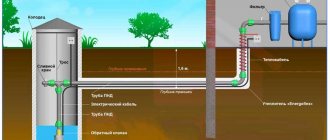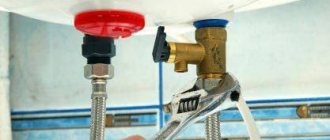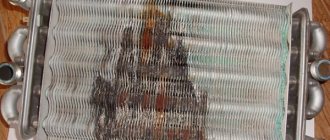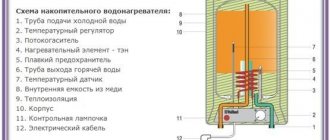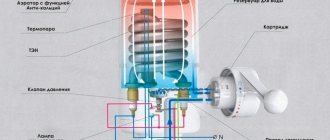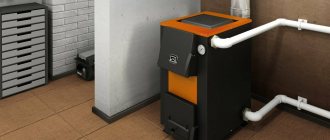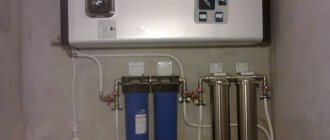Nowadays, having an electric water heater is not a luxury, but a necessity. Almost everyone has it, at home or in the country, in an apartment or a private house, it doesn’t matter, because the main thing is that there is always hot water. For many summer residents or owners of country houses, the issue of draining water from the tank during idle periods is very relevant. However, experts still do not have a clear answer on this matter; it all depends on the conditions and operating time of the boiler.
The most common brands of water heaters today are:
- Termex.
- Ariston.
- Electrolux.
Using their example, we will try to figure out whether it is necessary to drain the water from the water heater during downtime.
Finishing touches
Draining water from the water heater tank is not the end of the job, especially since a bit of moisture is still in the tank of the device.
The volume of liquid depends on the model/manufacturer of the device and the amount of scale/sediment. To completely empty the boiler of water, it is necessary to remove the tubular electric heater (TEH). To make removing the casing easier and more convenient, and to avoid problems with the electrical components, the device can be lowered to the floor and then hung back.
Before removing the last remaining moisture, often dirty sediment, place a bucket or basin under the tank. And have rags ready, as such work is often accompanied by accidental leaks. Unscrew the nut on the heating element and drain the water.
Important: if there is no need, you should not drain the water from the water heater. But if the reason is serious and the warranty has already expired, carefully follow the recommendations to avoid mistakes. To facilitate subsequent drains, tees can be installed on boilers
To facilitate subsequent drains, tees can be installed on boilers.
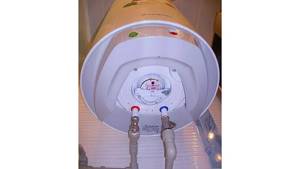
How to drain water from a boiler correctly
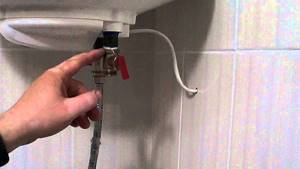
Valve for draining water from the boiler
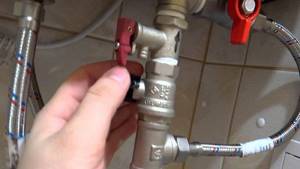
Draining water from the boiler
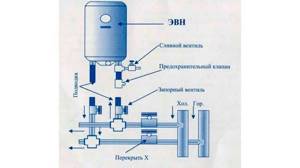
Connection diagram, supply and drainage of water from an electric water heater
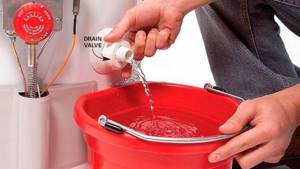
Drain the water from the boiler correctly

Draining water from the Ariston water heater
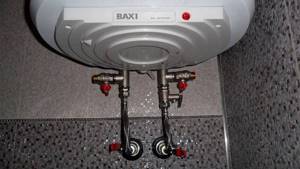
How to drain water from a boiler correctly
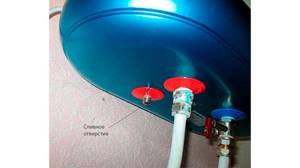
Draining the water from the Thermex water heater
Useful recommendations from professionals
Recommendations from experts will help eliminate common mistakes that will help prevent equipment failure:
Installation, connection and first filling with water must be carried out by a certified store specialist, with a mandatory mark in the warranty card. This guarantees that your equipment will be replaced if a problem is detected.
For a boiler installed in a heated room, draining the water when the owners leave is not necessary.
When reconnecting the wires, check the connection diagram included in the operating instructions.

Different models have their own connection characteristics.
It is better to replace all connecting rubber and plastic gaskets when draining the liquid. Consumables are sold in specialized and hardware stores.

To eliminate mistakes when purchasing, take the gasket with you and show it to the seller.
Manufacturers recommend regular maintenance once every few years. But regularity largely depends on the quality of the water in your home.

If the water in the water heater comes from a centralized water supply, it contains disinfecting components (bleach).
Water heaters are equipped with filters that need to be cleaned or changed regularly, so the heating elements will last much longer.
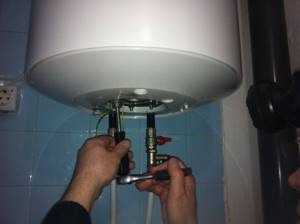
The time to replace the filter depends on the water heater manufacturer and its recommendations.
By adhering to the recommendations and instructions, the question of how to drain the water from the water heater will no longer confront you. And the equipment will serve the whole family for a long time.
How to drain a heating riser
1. Close the valves on the supply riser (1) and return riser (2).
2. Open the drain valves (3) and drain the coolant.
The second picture also shows a system with bottom feed. Only the supply and return risers are located in different rooms. Therefore, taps 1 and 2 can be spaced apart. And the procedure for draining the coolant is the same.
The third picture shows a system with top coolant supply. The supply line is located in the attic or under the ceiling of the upper floor.
Procedure for draining the heating riser:
- close valve 1 in the attic;
- find valve 2 in the basement and turn it off too;
- remove plug 3 and drain the coolant.
The same systems are made in multi-storey buildings.
It often becomes a necessary measure due to an emergency situation in the autonomous heating of the house or the departure of the owners for a long period of time in the winter. The question of how to do this was discussed in another article.
If you have a heating system with natural circulation installed (Fig. 1), you must immediately ensure that the boiler stops operating. Only after this can water be drained from the heating system.
. The discharge is made through a tap (valve), which should be located at the lowest point of the return line, usually next to the boiler. It is advisable to have a hose for this type of work. One end of the hose must be put on the tap, and the other end must be extended to the nearest place with soil, for example, a front garden, a vegetable garden, or, in extreme cases, drained into the sewer. After this, open the tap and wait until the hose stops flowing. It often happens that not everything has flowed out of the system; make sure that after removing the hose you can remove any remaining water.
Using the same method, you can discharge water from a heating system with forced circulation, which includes a pump that is not included in the boiler design. The reset procedure is the same.
Many modern systems are equipped with boilers that include a circulation pump (Fig. 2). The heating system installation method differs from the above, therefore, the supply and return pipes can be located above the baseboard or in the floor structure, just like the “warm floor” system.
1. First, turn off the boiler.
2. Place the hose on the tap from which water is drained from the heating system. It is advisable to put it on the return line (the right pipe coming from the boiler) to make a reset faster. If they are not under the boiler, find where they are. The other end of the hose can be directed into the sewer (a specially made outlet for drainage) or simply into a bucket.
3. Open the tap, wait until the water stops flowing (pressure drops) and turn off the tap.
4. Now we need to organize air access into the system. To do this, open the highest Mayevsky tap, usually installed on the heated towel rail (if equipped). If it is not available, on any radiator (for a two-story house, on the second floor).
5. Repeat the water draining procedure using the hose.
6. Now you can open all the remaining closed Mayevsky taps and repeat draining the water from the heating system again.
7. That's not all, now remove the hose from the return line and put it on the supply valve.
8. And reset again. The lower the hose is located along its entire length relative to the taps, the more water will drain from the heating.
Please note that water cannot be removed from the “warm floor” system in this way; a compressor or other equipment must be used.
Draining water from the heating system is not a quick procedure and requires some attention.
In what cases should the water be drained from the water heater, and in what cases is it unnecessary?
Descriptions of some situations in which it may occur to you to drain the water from the water heater:
- It may happen that the temperature in the room where the storage water heater is installed drops to the maximum permissible values and approaches zero. This happens in unheated rooms or during accidents. The water needs to be drained. Otherwise, the water will freeze and damage the water heater, and it can only be drained with the help of professionals.
- Failure of the magnesium anode, as well as other measures to repair the device. All this is done after draining the water. However, remember that the warranty may be void in this case.
- Cleaning the water heater from accumulated scale and other deposits. It is also necessary to drain the water. This is a planned event that can take place on average every 3 years, depending on the quality of tap water.
But you need to remember that unless there is an urgent need, it is better not to drain the water from the storage water heater.
Boiler in the country
Water heater in the country
If the water heater is installed in the country house and is used only seasonally, then the water must be drained for the winter.
This is especially true for those who draw water from wells and not from a water supply.
The thing is that central water can be specially purified and contains fewer bacteria that destroy the water heater from the inside.
If the dacha is not heated and there is a boiler there, it is necessary to drain the water in the winter, because at sub-zero temperatures the water in the tank will freeze and, due to its physical properties, will begin to expand. This will lead to rupture of the internal tank and damage to the water heater.
If the boiler is located in a room where the temperature is maintained above zero, and the owners come to the dacha at least once a week, then it makes sense not to drain the boiler or disconnect it from the electrical network.
This option will be optimal for using a water heater in a country house or country house.
Myths about an idle tank
Most often, the question of whether it is necessary to drain water from a water heater arises under the influence of myths that a person has heard. Among the most common:
- The water in the boiler will become rotten, it will breed pathogenic bacteria and harm your health. The water stagnates, but after pumping 100 liters of fresh water, little will remain of the previous environment. The liquid from the boiler is not used for food, and it undergoes good heat treatment. Few microorganisms survive at a constant temperature of 80 degrees. In addition, modern devices often have special antibacterial internal coatings.
- The tank will rust. The container can only succumb to rust if the water is drained from it! Metal does not oxidize in water, and this is easy to check: take two nails, throw one into the liquid, and wet the other and leave it in the air. It's easy to guess which one will rust. Modern tanks have an enamel or stainless steel coating on the inside, so this myth will soon become irrelevant.
- The heating element oxidizes and burns out. A heating element rusted under the influence of a small amount of moisture and a large amount of air in an empty tank will burn out much faster.
Thus, whether to drain the water from the water heater is up to you to decide, based on your specific conditions. If this is not absolutely necessary, then it is not worth it. In addition, if preventative and repair work is carried out by specialists, then it is better to leave this part of the procedure to them. They know exactly how to properly (if at all) drain the water from the water heater.
What are water heaters?
With its help, the desired heating temperature is set, and it also helps to save energy, since the heater is turned on only if the water drops to a temperature below the set one.
Their advantages include:
- Possibility to connect the required number of hot water points.
- High water pressure in the water pipe is not required.
- Low power consumption (up to 2KW).
The storage water heater is designed quite simply, but is reliable and economical. Its main components include: an internal tank and a heating element, a heating element. Later models are somewhat more complex
It works on a principle similar to the principle of operation of a heated thermos, therefore, in the latest developments, special attention is paid to the inner coating of the tank
Boiler device
Electric water heater includes:
- metal or plastic case with brackets and grooves for fastening;
- tank made of stainless steel or covered with glass porcelain;
- thermal insulation layer between the tank and the body;
- magnesium anode;
- tubular electric heater;
- safety thermostat;
- Control block;
- valve protection system;
- safety valve;
- temperature sensor (thermometer);
- indicator light;
- temperature indicator (analog or digital);
- electrical cable;
Draining water from Termex and Ariston water heaters
Next, we will look at how to drain water from Termex and Ariston water heaters. These water heaters differ only externally, but their internal design is almost identical. Only in some cases, Termex heaters have an additional outlet for draining water. What is needed to quickly drain the water from the boiler?
It will be much easier to drain water from the water heater tank if, when installing it, you install a special tap for draining the water.
The draining process must be taken care of even when installing the water heater. To do this, it is necessary to provide for the installation of a special drain valve on the cold water supply pipe. If it is not there, the draining process will be somewhat difficult - you will need to disconnect both pipes. If the tank is being cleaned, there is nothing to worry about. But if the water is drained in the winter, then fussing with disconnecting the pipe will be unnecessary.
How to properly drain water from a water heater? The process occurs in several stages:
- Disconnecting the boiler from the power supply in order to cool the water - do not climb under hot water, otherwise you can get burned;
- Turning off the cold water supply is a mandatory procedure when draining water;
- Relieving the water pressure in the tank - to do this, open the hot water tap, and after it stops flowing, close it again;
- Opening the drain tap - after this the water will completely drain, but before that you need to open the hot water tap again.
You may ask, why is the water drained through the water supply and not through the hot water tap? The thing is that cold water is supplied to storage water heaters from below, and goes to the water collection points from above. Since the water inside the boiler is under pressure, the pressure must be relieved before emptying - this is why the hot water tap is opened while the cold supply is closed.
In order to quickly drain the water from the water heater after releasing the pressure, we need to sequentially open the hot water tap and open the drain valve. The procedure is identical for both Ariston boilers and Termex water heaters. Opening the hot water will allow water from the tank to flow out through the drain valve under its own pressure - without an open tap it will not flow.
To drain water from boilers equipped with a special drain hole, you do not have to install a separate tap on the cold water supply hose.
In some heaters, water can be drained from the tank through a special outlet already built into the boiler design. One tube is used to supply cold water, another to discharge hot water, and the third to drain. But even in this case, you need to open the hot water tap and turn off the cold water supply.
Experts advise using a double drain system on boilers with a special drain pipe - through this pipe and through the drain tap. This ensures complete emptying of the tank.
Have you started draining your water heater through the drain valve located on the cold water supply pipe? Then you may encounter a problem where the water barely drains or does not drain at all. It is worth noting that this crane itself is not very productive. If you want to drain the water as quickly as possible, install a tee with an outlet here, which will act as a drain tap.
If the water drain tap is clogged or is simply not there, then nothing is stopping you from simply unscrewing the hose or tap from the filler hole and draining the water through it.
If water does not want to pour out through a regular drain tap, then it is most likely simply clogged - this often happens after long-term use without regular cleaning of the tank. In this case, you need to close the hot water tap, arm yourself with a wrench, unscrew the tap and clean it - don’t be afraid, water will not pour out of the boiler, since the hot water tap is closed. After cleaning the drain valve, you can quickly drain the water from your water heater.
Is there no drain valve on the cold water pipe? In this case, drain by disconnecting the supply pipe from the boiler and then opening the hot water tap. It is recommended to connect a hose to the supply tube and lead it into the sink or toilet so as not to flood the floors, furniture and neighbors below.
Method number 1: drain the water using a safety valve
Proper installation of the water heater requires the presence of a drain safety valve. It is installed at the entrance to the tank (on a cold pipe or hose) and is intended for emergency drainage of water from the boiler. This emergency drain occurs spontaneously if, for some reason, the pressure inside the tank exceeds the specified safe values.

The emergency valve has a spout for connecting the drain tube, and there is a screw (it looks like a handle that is used to open and close the valve). Why does the valve need to be opened? To check its functionality. This is done once a month. Open the valve handle and see if water flows from the spout. If it leaks, the valve is in working order. If it does not flow, the valve is clogged and does not perform a safety function. It needs to be cleaned or replaced.
Now the main thing is how to drain water from the boiler using a valve? This is the easiest way to empty the heating tank of water. You just need to open the valve of the emergency device. If the valve is working properly, water will flow from the spout (or the hoses that are attached to the spout).
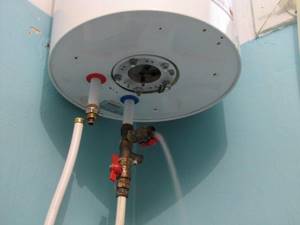
The flow rate of water through the safety valve is low. This means that a tank with a capacity of 80 liters will be emptied in about 2 hours. If the valve is clogged, the flow rate of water will be even less. In this case, the boiler release time may be 3 or 4 hours. To quickly drain the water from the tank, you must use the method described below.
Video about draining water using an emergency valve
In the plot you can clearly see the process of draining water.
Union of water heater and water
Water is a chemical substance whose formula - H2O - is known by heart by almost all people, young and old. However, a liquid that is far from crystal clear can affect the operation of any equipment. This statement is true for both washing machines, dishwashers, and water heaters. In the first two types, water does not remain for a long time, so there is no great risk for them, but even they are not affected by water in the best way.
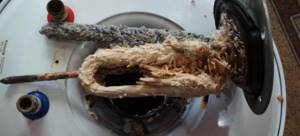
If we talk only about water heaters, then their prolonged contact with “life-giving moisture” leads to several problems:
- Bacteria and other pathogens multiply inside the units. This is believed, but this statement can be argued, because the hot temperature of the liquid is still not the best place for salmonella, E. coli and their “harmful colleagues” to live.
- Over time, the inner surface of the tank is sure to become covered with plaque, which can sometimes be quite difficult to remove.
- If the water freezes, then the ice will become a direct threat to the components and connections of the structure, since deformation of the boiler is inevitable.
The first problem may be encountered by those owners who heat the liquid to a minimum temperature - up to 45°. The first sign of an “invasion of microorganisms” is an unpleasant odor coming from the water. In this case, you don’t have to look for an answer to the question of whether it is necessary to drain the water from the water heater: it’s easy to defeat “living creatures” - you just need to change the heating degree for a while, set the maximum temperature. If a single operation does not bring results, then the procedure is repeated 3-4 times.
Why is the procedure needed?
The need to drain liquid from the boiler becomes urgent if the room temperature drops to five degrees Celsius or more. This is a serious indicator that allows you to think about starting work.
Temperatures with a minus sign are especially dangerous for batteries and fluid heaters. This situation creates a real threat of significant damage to the device and harness. The water heater is designed to operate only at positive temperatures, as many manufacturers write about in the instructions. Therefore, if the unit is put into winter storage, then the water must be drained from it.
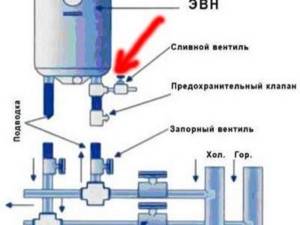
In Russia, winter realities are more severe than in warm Europe or Asia. Therefore, if you leave the water heater full in an unheated room, it will deteriorate. In addition, the boiler must be cleaned periodically, because the quality of water and the degree of its hardness in different regions can vary significantly. The time intervals between maintenance cleanings may vary depending on conditions.
Instructions for turning off the boiler
Before releasing the boiler, preparatory work is carried out.
- De-energize the unit. The plug is pulled out of the socket or the machine is turned off. Take an indicator screwdriver and check the presence of electricity on the contacts.
- The water supply tap in the apartment is turned off. If this is not the case, the flow of liquid is stopped by a valve in the basement.
You can empty the boiler of water only after it has cooled down. After turning off the electrics, you need to wait for the liquid to cool. Then the pipes through which water is supplied are removed from the boiler.
Long term shutdown
To prevent rust from forming inside, the boiler must be emptied of water for long periods of inactivity.
Sometimes you need to turn off the boiler for the winter and drain the water. Microorganisms multiply in liquids without heating. If the unit is located in an unheated building, the water will freeze and the boiler tank will rupture. It is recommended to turn off and dismantle the heater if the unit is to be changed or the room is decorated.
Boiler shutdown sequence:
- stop heating by turning off the heater from the network;
- turn off the cold and warm liquid supply taps going to the unit, the water will remain in the tank and will not drain;
- open the check valve on the housing.
Disconnection with dismantling
Before dismantling the boiler, unscrew the fastenings of the heating element and drain the water
The boiler must be turned off and removed from the partition. You cannot dismantle a boiler whose tank is filled with liquid inside; it must be drained to reduce the weight of the tank.
Procedure for draining and dismantling:
- close the valve on the hot tube;
- place a vessel for drainage or direct the hose into the bath;
- disconnect the junction of the cold riser and the protective hydraulic valve;
- unscrew the nut connecting the valve to the cold line fitting;
- regulate the flow by opening the valve;
- the water will go away in a few minutes.
It is easy to remove the unit if it is located on hooks
Dismantling requires care to avoid damaging parts
Turning hot water off and on
The city main can start working again, then you can turn off the boiler if you have hot water. The plug is removed from the socket and the contents cool down. You can drain half the liquid and add cool to make the process faster.
To drain, close the tap on the cold pipeline and disconnect the corresponding pipe. A hose is attached to the free end and placed in the sink. The valve is unscrewed and the drain valve opens. The water mixer turns to the hot position. After this, the supply valve from the city water supply is turned on.
Instructions
Emptying the Thermex water heater tank
The process of draining water from a Thermex boiler consists of several stages:
- First, prepare the necessary tools: a gas adjustable wrench and a rubber hose. Using a wrench, close the cold water supply pipe to the tank.
- To prevent a vacuum from forming inside the container, open the hot water tap on the mixer.
- Drain the water until the arrow on the boiler reaches the zero mark. When this happens, close the hot water tap.
- At the point where cold water enters the tank, unscrew the check valve nut using an adjustable wrench.
- Connect one end of the rubber hose to the cold water supply pipe. Lead the second end of the hose into the sewer or into a previously prepared container. Disconnect the hot water outlet from the unit. When you do this, water from the tank will flow through the hose.
- Unscrew the nut that secures the hot water outlet. After this, air will begin to enter the boiler, and the tank will empty completely. It happens that water does not immediately begin to flow out of the container; in this case, you need to blow into the hose.
- After draining the water, screw back all the unscrewed nuts.
Accompanying video
How to remove Electrolux brand from equipment
The advantage of Electrolux water heaters is their economical heating mode, which prevents the formation of scale on the inner surface of the tank. It is best to drain water from such boilers using a check valve located on the inlet pipe. Let's look at the process step by step:
- First you need to shut off the cold water supply to the tank by tightening the appropriate valve.
- Then you should put a hose of suitable diameter on the drain hole of the safety valve, and lead its other end into a prepared container or into a sewer drain hole.
- Then you need to open the hot water tap on the mixer. The flag located on the side of the protective device should be raised so that water begins to flow out through the drainage hole.
As when working with other water heaters, the Electrolux boiler must be disconnected from the power supply before starting work.
Emptying the Ariston heater
To empty the Ariston water heater tank, you will need not only an adjustable wrench and a hose, but also a straight screwdriver and a 4 mm hexagon. We will describe the process of emptying the container step by step:
- After disconnecting the boiler from the power supply, close the tap valve for supplying cold water to the tank.
- To equalize the pressure inside the unit, unscrew the hot water tap.
- Now you need to make sure that air gets inside the boiler. To do this, open the tap on the pipe supplying hot water from the boiler.
- Connect a rubber hose of a suitable diameter to the device, open the water drain valve and empty the tank completely.
Video hint
Correct emptying of the Gorenje boiler
The principle of draining water from a Gorenje water heater is similar to the cases described above, the whole process consists of the following actions:
- First, the boiler is disconnected from the power supply. Then open the valve on the hot water mixer.
- After waiting until the hot water has completely drained, a hose is connected to the cold water tap, the return end of which is led into a sewer drain or into any suitable container.
- By opening the drain valve and ensuring air supply to the tank, the boiler is emptied. This process takes about 10 minutes.
The water from the Gorenje heater can be drained through the safety valve. Many people use this simple method, but this process takes a lot of time.
When drainage is required: popular reasons
Reason #1. The water heating tank needs to completely drain the liquid if the room where the equipment is located is not heated for a long time.
For example, it could be a summer house that is not suitable for winter living, or any other property that is rarely visited by the owners, where the average temperature drops below +5°C.
In this mode, the water in the storage tank and pipes may freeze and there is a risk of damage to the internal structure of the container and piping. Therefore, it is better to carefully drain the liquid in advance and preserve the system itself until a more appropriate time.
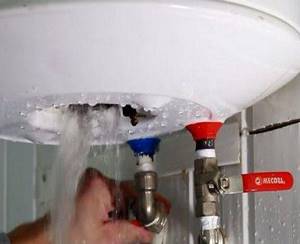
If the boiler is not planned to be used for its intended purpose for a long time during the warm season, you can not drain the water completely, but simply let it flow and renew itself once every 15 days. Then the water will not stagnate, and an environment comfortable for various microorganisms will physically not be able to form inside
If it is expected that the device will not be used for a long time, then the contents in it can be updated once every 2 weeks by opening the hot tap on the mixer for a few minutes. This way the water will not stagnate and harmful microorganisms will not appear in it.
Reason #2. Routine cleaning is another good reason to completely empty the boiler. It is carried out once a year where water of a high level of purification, containing a minimum of impurities, is centrally supplied.
Twice a year the tank is cleaned with the constant use of running water entering the system directly from the tank and not passing through treatment manifolds.
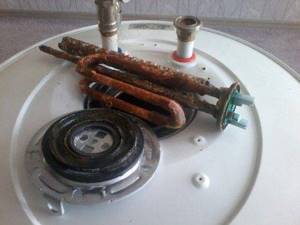
When the heating element is covered with a thick layer of scale, the water heater begins to consume significantly more electricity during operation. According to experts, consumption increases by at least 25%, and in some particularly advanced cases reaches 50%
In addition, during operation, dirt and harmful bacteria accumulate inside the boiler, and the bottom, walls and heating element become covered with scale. As it settles on the heating element, it turns into a kind of heat insulator.
Then the following situation develops: the device itself becomes very hot during operation and begins to overheat. In this case, running water practically does not change the temperature and enters the system barely warm.
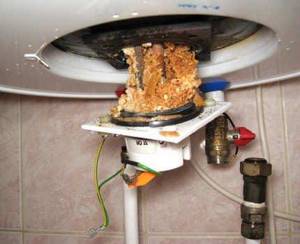
A water heater that is too clogged with waste generated during operation will experience poor performance. The load on all key components increases and the equipment wears out much faster than stated by the manufacturer
The efficiency of the unit drops to a minimum with intensive electrical consumption. To fix the problem, you need to drain the tank, remove the heating element and clean it of scale. Then, in the near future, the equipment will be able to fully operate and the water heater will not need to be completely replaced for a very long time.
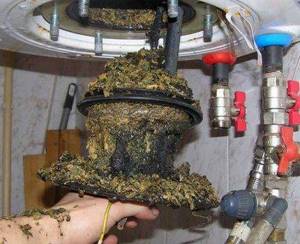
The sediment formed during operation in the storage tank negatively affects the quality of water heating and impairs its full permeability. In order for the device to function properly again, you will have to completely drain the liquid, carefully remove all deposits, and only then continue operation as usual.
Reason 3No. Emptying the tank may be necessary when the unit has already expired its warranty period, but one of the working components has broken down.
To repair or replace the heating element or magnesium anode yourself, you will have to completely drain the water, carry out all the necessary repairs, then reconnect the equipment to the system and fill it with fresh water.
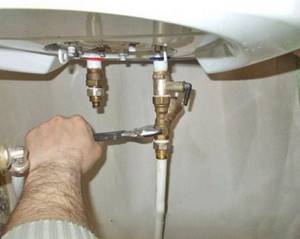
The presence of a leak will also require mandatory draining. Otherwise, finding the weak spot and fixing the problem will be very problematic not only for the home handyman, but also for a professional
Reason #4. Another serious reason for draining water is the unpleasant odor emanating from the tank. It usually appears when the equipment is used very rarely. Water that is in a container without regular renewal stagnates, begins to silt and smell.
After the tank is completely emptied and filled with fresh liquid, the “aroma” disappears and no longer bothers residents with unpleasant fumes.
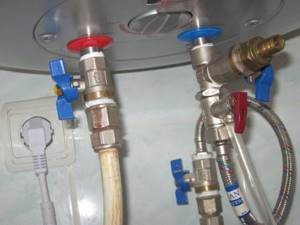
To prevent limescale deposits from remaining inside the tank, preventing the safety valve from working properly, some home appliance manufacturers recommend that customers drain a small amount of water each month through a separate drain pipe
Reason #5. In addition to all the reasons listed above, emptying may be necessary if the tank is dismantled and moved to another location, for example, during redevelopment of the premises and ongoing major or cosmetic repairs.
How to turn on the water heater
So, you are the proud owner of a home water heater. Finally, the “X” day has come, when the hot water is turned off in the entire house, and you can rightfully take advantage of your new acquisition. The only problem is that you have no idea how to use the water heater correctly, which buttons to press and taps to turn to make the miracle machine work.
To properly start a water heater, you do not need to have specialized education; you just need to follow a number of simple steps:
- Step one: shut off the hot water supply in the riser pipe. To turn off the water, you need to turn the valve on a special tap clockwise until it stops. The taps themselves are located on the water pipes from the risers. This step is necessary in order to use resources more economically and use the water heater correctly. If you skip this step, your boiler will heat water for the entire house.
- Step two: turn on the hot water on the faucet. After you turn off the hot water, only cold water will remain in the common pipes. Stopping the flow of hot water from the faucet will indicate that you have completely cut off the supply of hot water in the common pipes. 3. Step three: open the boiler taps. When using centralized hot water supply, the boiler taps must be closed. If we look at the water heater design, we will find three taps. According to the standard, the tap on the right is responsible for the flow of cold water, the tap on the left is responsible for hot water. The faucet located above the cold water tap is the safety valve. It is used for repair work. In our case, we work with the first two taps. First you need to open the cold water tap. Thus, we will start the process of water entering the heater tank. Only after this do we open the hot water tap.
4. Step four: turn on the hot water on the faucet. This action is necessary in order to bleed air from the heater and start the boiler. 5. Step five: connect the boiler to the electrical network. Do not forget to insert the power cord of the water heater into the outlet, after which the power connection indicator on the control panel should light up.
In order to turn off the boiler, you must perform the same steps in reverse order:
- disconnect the heater from the power supply;
- close the boiler taps through which water flows in and out;
- Renew hot water supply in the riser pipe.
To use the water heater more economically, it is recommended to disconnect the heater from the electrical network if you do not plan to resume its operation in the near future.
Using a water heater for water is a simple matter, but many questions may arise during the operation of the boiler. Below are answers to the most common ones.
Basic methods
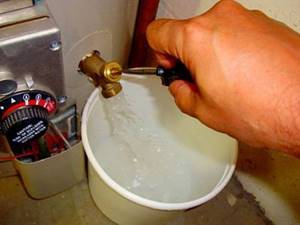
To drain water from the boiler, you need to provide air supply inside the tank.
There are several ways to drain water from a water heater. Whichever of them is used, you first need to disconnect the device from the network, and then leave it for a certain time so that the liquid in it cools down.
While the water cools, everything necessary to drain it is prepared. You can use a bucket or hose. Its end is lowered into the toilet or bathtub, and then secured so as not to hold the hose all this time. The draining process itself lasts about 20 minutes. Next, turn off the cold water supply. Open the hot water tap on the mixer in order to reduce the pressure in the boiler and allow air to enter the tank.
Finally, connect the drain hose and open the valve on the cold water pipe.
Draining process:
- First, before work, you need to turn off the electrical device from the network.
- Then wait a certain time so that the liquid in the boiler tank can cool to a safe temperature, which will reduce the risk of possible burns during the process of draining the water.
- Next, the cold water supply to the device is shut off.
- Afterwards, you need to open hot water on the mixer, or turn the lever to the desired position to remove the pressure inside. You need to wait until all the liquid comes out of the pipe.
- The next step is to unscrew the tap located on the hot water pipe in order to ensure the passage of air into the tank.
- Next, you just need to open the drain valve, which is located on the cold water pipe leading to the boiler, and, by connecting the hose responsible for drainage, release all the liquid into the sewer.
- Finally, make sure that all the water has completely drained out of the tank.
How to drain water from a Thermex water heater?
- Turn off the cold water supply tap.
- Then turn off the hot water tap on the mixer.
- Afterwards you just need to wait for the water to stop flowing. Draining takes approximately one minute.
- Next, the tap is turned on.
- Then, using an adjustable wrench, unscrew the cold water supply nuts to the check valve, which are located below it. Fears that the boiler will start to leak are groundless, since the design is specially designed in such a way that it does not allow hot water to penetrate into the cold pipe.
- Then the check valve is twisted, having previously prepared the drain hose into the sewer. After this action, water may flow out of the pipe. Therefore, you need to quickly attach the hose to the pipe.
- The next step is to unscrew the nut on the hot water pipe. After this, air will enter the system and the liquid will begin to flow into the hose. If this does not happen, you need to “clean” the hose.
From an Ariston water heater
- The mixer tap and the water supply tap are screwed on.
- The shower hose and the safety valve of the outlet tube are unscrewed.
- The hose that supplies water is unscrewed and directed into the tank. Water will begin to flow out of the inlet pipe.
- Unscrew 2 plastic nuts of the outlet and inlet pipes.
- The mixer handle cap is disconnected, then the screw is unscrewed, the handle and the plastic gaskets around it are removed.
- The boiler body is removed from the tank, towards the mixer, without removing it completely.
- Using a hexagon, the metal plug on the top of the mixer is unscrewed.
- The liquid drains completely from the hole where the plug was located.
Considering the fact that water heaters are used only for a few weeks or days, when the hot water is turned off, usually in the summer, most people wonder whether it is worth draining the liquid from the boiler if it is not used for a long period.
There is no definite advice on draining liquid from a water heater, as it depends on the current situation. If the boiler is broken and does not perform the heating function, then the liquid does not drain. Then you should contact the service center, in particular if the device has a warranty card.
In general, before using any household appliance, including a water heater, you must carefully read all the technical documentation supplied with the device, since it is often there that the answer to the question is it necessary to drain the liquid from the boiler during a long period of inactivity .
Do I need to drain the water from my water heater?
As long as the boiler is operating normally, it does not need to be emptied.
Moreover, draining the water is even undesirable.
When in contact with air, or more precisely with the oxygen contained in it, metal parts, especially wet ones, begin to quickly rust.
Protection in the form of a magnesium anode in this case turns out to be absolutely useless, since it can only effectively manifest itself in an aqueous environment. Thus, the service life of the device, from which water is often drained, will be very short.
There are, however, cases when it is impossible to do without draining the water. But if the warranty period for the boiler has not yet expired, again you should not do this yourself. This operation, like repairs, should be done by a technician from the service department. If you nevertheless try to take on this honorable responsibility, the matter may end in a refusal of warranty repairs. It’s no secret that sellers and service workers try to use any reason for this, even the most insignificant, and your initiative will play into their hands.
Well, if the warranty is no longer valid, you can safely take out the tools: your hands are free, and no one can blame you for your initiative.
In case of breakdown
The need to perform repair work, preventive maintenance, as well as transport the water heating device to a service center, requires the mandatory and complete draining of water from the storage boiler tank.
However, if the purchased water heating equipment is under warranty or requires an agreement to extend the maintenance period, then if a breakdown is detected, you must call a qualified technician who will determine the need to empty the tank and carry out repair measures.
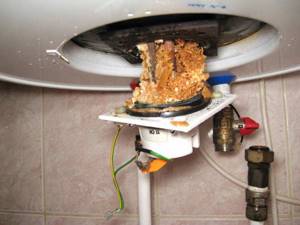
Faulty boiler
Storage water heating equipment belongs to the category of simple household appliances, represented by a container and a pair of pipes for supplying cold water and discharging heated water.
The cold water inlet is usually located on the right side of the water heater and is indicated in blue. In the same part, protective fittings are installed, which is represented by a check valve device.
With the help of such an element, the growing pressure inside the tank is relieved and the reverse flow of water flow into the water supply network is prevented. The check valve, even with the wiring removed, will not allow water to spontaneously drain from the storage tank.
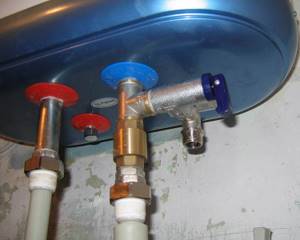
Check valve on the boiler
Another wrong decision is often to turn off the water at the inlet pipe to the storage tank, and then unscrew the hot water supply tap. If the pipe is too long, this method will remove no more than a couple of liters of hot water.
Complete emptying of the storage tank can only be achieved by de-energizing the boiler, turning off the cold water supply and unscrewing the hot and cold water wiring.
Do I need to drain the water from the water heater?
This depends on its operating conditions, design and frequency of use of the boiler. When does it become necessary to drain the water?
- if the water heater is located in a country house or in another periodic residence. With the onset of frost, the water inside can turn into ice and “break” the sealed storage tank;
- draining water is useful when there is a water supply accident and there is no water in the apartment. The storage tank can provide 80-100 liters of water. It can be used to wash hands, vegetables or flush the toilet.
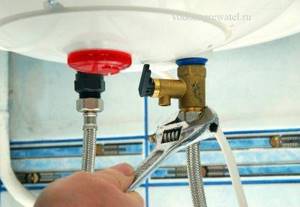
Should I drain the water from the water heater or is it not necessary during departure? For a boiler installed in a heated room, draining the water when the owners leave is not necessary. However, you need to take into account the design features of your heating device:
- If the tank is made of stainless steel, it is not afraid of corrosion in water. But it will corrode faster in humid air;
- For copper heaters, it is better to drain the water. Copper is more degraded in hard water than in humid air. And the service life of heaters is always shorter than that of a storage tank (they have to be changed more often);
- If the water in the water heater comes from a centralized water supply, it contains disinfecting components (bleach). They limit the growth of any bacteria and the appearance of an unpleasant, stagnant odor;
- If the water in the tank comes from a well, it does not contain chlorine. Therefore, it may stagnate with the formation of a putrid, unpleasant odor. Draining such water prevents its stagnation and decay.
In country or country houses that are not used for living during the cold season, care must be taken in advance to prepare all engineering systems for winter. It is necessary to completely empty the water supply and heating circuits of water. This also applies to water heating devices.
We will tell you how to drain water from a water heater quickly and accurately, and in what sequence the work to preserve the systems is carried out. We describe in detail all the options and methods for removing water from equipment. Rules for disassembling equipment that must be followed are given.
We supplemented the information presented for review with visual diagrams and illustrations, step-by-step photo guides and video instructions.
Why do you need to drain the water and when is the best time to do it?
Water from the boiler must be drained in the following cases:
- If the water heater is located in an unheated area, the tank must be emptied before winter arrives. With the onset of frost, the liquid will begin to turn into ice and increase in volume, which can lead to serious damage to the device and loss of its functionality.
- If the warranty period for the boiler has expired, and the structure needs to be repaired or the magnesium anode replaced, the water must also be drained. All such procedures are carried out only with a dry and clean tank. It is worth noting that during the warranty period you cannot carry out repairs yourself, otherwise the warranty will become invalid.
- At least once every 5 years, the water heater must be descaled. If the water supplied to the tank is not of good quality, it is advisable to carry out a similar procedure more often. The sediment that remains in the tank interferes with the rapid heating of water, which means that the boiler consumes more electricity to operate.
Now I would like to consider cases when there is no need to drain water from the boiler:
- When turning off the water heater during the warm season, it is not recommended to drain all the liquid from the tank. If the device is not threatened by frost, it is better to leave some water in the container - this will protect the interior of the tank from corrosion. In addition, if, out of forgetfulness, you plug in an empty boiler, a fire hazard may arise.
- If the device has been left unplugged for some time and the water in it has stagnated, it is also not worthwhile to completely empty the container. Stale water simply needs to be refreshed by filling the tank full several times. It is advisable to repeat this procedure every 3 months, running 100 liters of cold water through the heater.
- If the unit is still covered by the warranty, it is highly not recommended to drain the water, much less repair any parts yourself. In such a case, the warranty will become void. If problems arise with the boiler, it is better to simply call qualified specialists. They will drain the water themselves, fix the breakdowns and do it for free.
You can use a suitable container to drain water from the boiler.
Why drain the water?
If you do not drain the water from the boiler on time, the following problems will arise:
- Bacteria and pathogenic microorganisms (E. coli, salmonella, etc.) will appear in the water heater. This point is controversial because microbes do not live in places with high temperatures.
- The tank will become coated with a coating that will be difficult to clean.
- The water will freeze and the boiler will begin to deform. Due to constant pressure, hydraulic components and connections will suffer.
The first point requires detailed consideration. The explanation is simple: when bacteria appear in water, it gives off an unpleasant odor. Similar situations are observed among those who heat water to 45 degrees Celsius and no more. You can do without draining the water: you need to set the maximum heating temperature. Then the foul smell will disappear.
If it was not possible to achieve the desired result, it is better to use another method: heat the tank to an extremely high temperature, repeat this procedure 4-5 times.
Other methods are ineffective; you will have to drain the water.
Some water heaters require drains by default due to the design and design of the heating element (tubular electric heater).
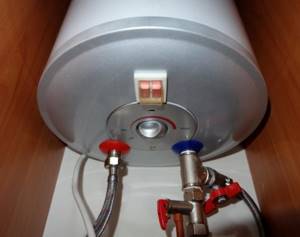
Periodic use of the boiler
Some people think that without water the internal tank will rust, and do not know for sure whether it is necessary to drain the water from the water heater for the winter in the country, if it is not used regularly.
If the boiler is used only in the summer and is completely idle in the winter, then you must follow the rules for operating the device:
- you need to unplug the water heater
- cut off the water supply
- drain the water completely
- unwind the boiler to completely remove moisture
If you simply drain the water without spinning the heater, it will damage it. As a rule, water contains microbes and fungi that do not have time to harm the inner surface of the water heating tank with regular use.
How to drain water from a boiler yourself: step-by-step instructions

A boiler is a storage water heating tank that does a good job of providing residents with hot water both in a private house and in an apartment. Its popularity among the population is understandable: to install such a heating device, an ordinary socket with a standard connection is required, since its power does not exceed 1.5-2 kW.
During operation, situations may arise in order to resolve which it is necessary to drain the liquid from the tank. This can be done without the help of specialists.
How to drain water from a storage water heater?
Most often, the boiler tank is hung on the wall or mounted on supports. Two pipes or two flexible hoses are connected to the water heater from below - cold and hot. Cold water enters the water heater through the cold inlet pipe (hose). Hot water comes out through the hot hose.
The hot water is released while the tank is simultaneously filled with new cold water. When the cold water is turned off (in the event of a water supply accident or repair of the riser in the entrance), cold water does not flow into the tank. Therefore, hot water cannot flow out of the boiler even when the tap is open. Now, based on the described operating features of the water heater, we will tell you how to properly drain the water from the boiler.
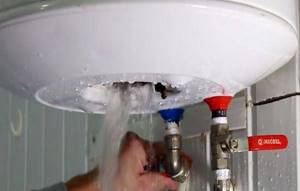
To do this, it is necessary to open the cold hole (cold water outlet) and at the same time ensure air access into the tank through the hot water outlet. How to do this depends on the design of the boiler and the method of its connection (read here how to install the boiler correctly). We will look at several ways to implement our plans.
Preparation and draining
First you need to make some preparations.
Before starting the operation, you need to prepare a piece of rubber hose and a gas wrench (second number).
Then disconnect the boiler from the power supply and wait a while until the water in the water heater cools down.
Now you can get to work:
- Close the valve mounted on the cold water supply to the boiler.
- Open the hot water tap on any of the faucets connected to the water heater. By draining a certain amount of water, you will release the residual pressure in the device’s container. Further actions depend on the connection diagram. If you nevertheless neglected the manufacturer’s recommendations and installed a drain valve in the inlet section between the boiler and the check valve, all that remains is to connect the hose to it and turn the knob counterclockwise, after first running the other end of the hose into the toilet or bathtub, whichever is closer. The “hot” faucet of the mixer must be left open to allow air to enter the system. If you do not find a drain valve above the check valve, proceed to the next step.
- Close the faucet that was used to relieve excess pressure, and also make sure that other faucets connected to the water heater are tightly closed.
- Using a gas wrench or other suitable tool, unscrew the nut under the check valve that secures it to the pipe. This can be done completely calmly, since the entire supply of water in the boiler is still securely held by the check valve.
- Before starting the next operation, place a bucket or other container under the water heater inlet. Now you need to dismantle the check valve by unscrewing the second nut. A certain amount of water may flow out of the vacated pipe, but not much at all: the liquid in the tank will be retained by the vacuum, because by closing all the mixers, we have blocked the access of air to the system.
- Quickly place a hose on the inlet pipe and lower its free end into the drain hole of any sanitary fixture.
Open the hot water tap on any of the mixers, allowing air to enter the system. After this, water from the tank will begin to flow freely and flow through the hose into the sewer.
microclimat.pro
